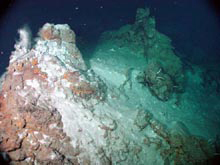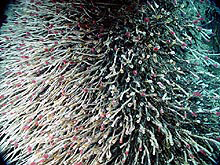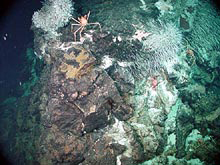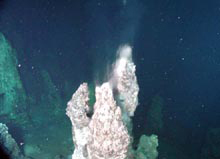
Shimmering water spews forth from the newly discovered “Cleopatra's Needle.” Notice the majestic spires of surrounding vent chimneys in the background at the Mystic vent field within the Magic Mountain area. Click image for larger view.
Eruptive Discoveries
July 29, 2002
Bill Chadwick
Geologist
Vents Program
Pacific Marine Environmental Laboratory, NOAA
The three ROPOS dives that we have made so far (r664, r665, r666) have all explored the Magic Mountain hydrothermal area at Explorer Ridge, which, though discovered 18 years ago, has never been systematically sampled and mapped. Our first dive located the vent field, the second sampled vent fluids from a number of its active chimneys, and the third conducted biological sampling and geological mapping at several vent sites. During each dive we discover more and more active chimneys, each made of sulfide minerals and formed where hot spring water exits the seafloor. We now have located and named 15 individual active chimneys with several times that number seen, but so far left unnamed. Each one seems to be different from the rest in terms of its shape, size, composition, and the kinds of vent animals that live around it. Some chimneys stand alone, tall and narrow like a saguaro cactus. Others are clustered or have grown together to form walls with individual outlets in a row at the top. Still others stick out the top of sulfide mounds like a birthday cake with candles. Some are covered with large tubeworm colonies, while others have no tubeworms at all. These differences in appearance are probably due to variation in the chemistry of the vent fluids from site to site. In the days ahead we plan to collect additional samples of the vent fluids, the chimneys, and the animals and microbes living around them.
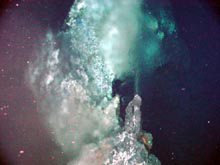
“Thar she blows!” This anhydrite and sulfide chimney, at Majestique vent field, projects hot vent fluid into the frigid deep-sea waters. Seven of the many anhydrite mounds in this region were mapped and named by the American and Canadian collaborators on this Ocean Exploration expedition. Click image for larger view.
Discoveries at Explorer Ridge
Kimberly Williams
Teacher at Sea
For the last few days, the weather has cooperated beautifully. We've had two amazing dives in which we were able to explore, map, and sample in completely uncharted areas of Explorer Ridge. The ROPOS engineers told me yesterday when we started the dive that ROPOS could outlast me, but I didn't believe them —I'm pretty stubborn. Well, guess what? They were right. Like everyone else, I desperately craved sleep by the time my shift was over, but I just couldn't take my eyes off this beautiful scene. Just when I thought I was going to collapse from exhaustion, we approached another location with new and amazing rock formations, and the excitement would start all over again. The first vent was covered with wisps of filamentous bacteria and creepy white sea spiders. We spent quite a bit of time exploring this new region and getting acquainted with the marine life here. The critters were familiar, but in different degrees of concentration than what had been seen at other vent fields. Even the vents themselves looked different here.
At the first vent we studied, we saw a crazy cap of worms coated in a bacterial mat that reminded us of Einstein's classic hair-do, so naming it was pretty easy. I guess every other vent we would see at Explorer Ridge would be "relative" to what we saw at Einstein vent.
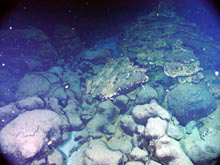
Pillow lavas and breccia at the base of this slope are overlain with slabby pieces of sulfide formed from hydrothermal venting on the east side of the Southern Explorer rift zone. Click image for larger view.
After collecting as much water, bacteria, benthic organisms, and rocks as ROPOS could hold, the vehicle was brought back to the surface, and the engineers quickly prepared the sub for a second trip to the bottom. As ROPOS made its way down, I was beginning to get very sleepy. The water through which we descended was mesmerizing, even on the video screens. It was a deep sky blue dotted with small organisms and particles of detritus that reminded me of a gentle snowfall on a quiet night. As we descended, it turned to an even darker, deeper blue than you can imagine, and then all of the sudden, I saw them—pillow lava formations as far as ROPOS's lights could reach. I somehow made it back to my bunk and drifted off to sleep thinking that these formations must be softer than the bed where I was sleeping. Before I knew it, it was time for my shift to start again.
All through the night, people took shifts napping and exploring the new site. Using very fine mesh nets that looked like airport windsocks, the larval biologists sampled in an area we named “Tubeworm Chimney.” Also, for the benefit of micro- and macrobiologists and geologists, ROPOS was used to conduct what is known as "suction sampling," which is akin to what you would do if you were conducting a scientific study of the mysterious world existing in the space between your couch cushions. Using a powerful suction hose, anything in the area that is not attached (or at least, not very well attached) is pulled into a sample container. ROPOS holds eight containers, which makes it very convenient to compare samples from one vent to the next. I anxiously await the moment when ROPOS is back on deck and I can peek into the sample jars to see the rocks and critters with my own eyes. I can guarantee that what we'll find will be far more amazing than what's between my couch cushions!
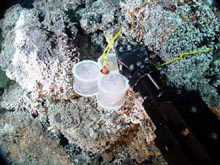
The ROPOS claw positions a bacteria trap along the side of Einstein vent at the Mystic vent field of the Magic Mountain area. These traps provide a habitat for bacteria and archea, which will be studied in Dr. Craig Moyer's laboratory at Western Washington University. Click image for larger view.
Another item on the dive plan for the second dive was rock and mineral collecting. By using ROPOS's manipulator arm we were able to pluck samples from the site and place them in ROPOS's “purse”—a chain mail bag that is attached to the front of the sub. This activity requires amazing skill on the part of the ROPOS pilot. It reminded me of the carnival game with the claw where you have to try not only to grab the best toy, but also to very carefully bring it over to the window and drop it into the chute. After several “practice attempts,” we finally won the game and were rewarded with some choice selections of basalt, lava and sulfides.
Minus any scary sea monsters, the rest of the dive was like an adventure novel. ROPOS flew over sulfide chimneys of varying ages, activity level, and colors that resembled something different to every person in the room. Once our sample collectors were full, it was time to return to the surface. By the end of the dive, we had explored, mapped, and sampled in the Magic Mountain area and beyond, and yet there was still so much to see! We might never be finished! When the sub finally surfaced, every tired and bleary-eyed researcher tumbled out to the deck and eagerly waited for the crew to secure ROPOS to the deck so they could scoop up their samples. While people scrambled to preserve and start examining their samples, the engineers prepared ROPOS for our next adventure, which will begin in a few short hours. I can't wait! By the way, they were right. ROPOS can definitely outlast us!
Sign up for the Ocean Explorer E-mail Update List.























